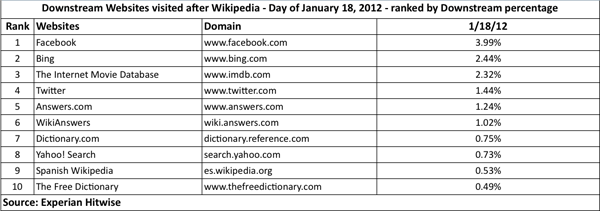Who Got Web Traffic When Wikipedia Went Down? Facebook, Twitter & Answer/Homework Sites, Of Course
When Wikipedia, the fifth most-visited site on the web (source), went offline for 24 hours last week as part of the mass SOPA/PIPA legislation protests, millions of Wikipedia users were left in a state of virtual limbo. What to do? Where to go? Who ended up getting all the traffic while Wikipedia was down for […]
 When Wikipedia, the fifth most-visited site on the web (source), went offline for 24 hours last week as part of the mass SOPA/PIPA legislation protests, millions of Wikipedia users were left in a state of virtual limbo. What to do? Where to go? Who ended up getting all the traffic while Wikipedia was down for a day?
When Wikipedia, the fifth most-visited site on the web (source), went offline for 24 hours last week as part of the mass SOPA/PIPA legislation protests, millions of Wikipedia users were left in a state of virtual limbo. What to do? Where to go? Who ended up getting all the traffic while Wikipedia was down for a day?
According to Experian Hitwise, Wikipedia’s loss was a win for Facebook, Twitter and several answer/homework websites.
This first chart shows the overall downstream traffic from Wikipedia on January 18th – the day of the protests. Facebook was the most visited site from Wikipedia that day, with just about four percent of the overall traffic.

To compare, Hitwise says that Facebook was the fourth most-visited site from Wikipedia on January 17th — the day before Wikipedia went offline. Bing went from the No. 6 most visited downstream site on the 17th, up to No. 2 during the protest on the 18th. Sites like Answers.com and Dictionary.com — potentially good sources of help for homework doers — also made the top ten on January 18th after not making the top ten a day earlier. Spanish Wikipedia and The Free Dictionary were also not among the top ten sites visited after Wikipedia on the 17th, but made the top ten during the protest.
What I can’t explain is this: On January 17th, Google was the most visited site from Wikipedia, but on January 18th it wasn’t among the top ten. (Go figure.)
This next chart looks at which sites saw the biggest percentage gain in downstream traffic from Wikipedia. The clear winner here is Twitter, which saw 534% more traffic from Wikipedia during the protest than the day before.

Research sites like Biography.com and InfoPlease.com also saw a lot more traffic from Wikipedia during the blackout than they normally do.
And note that Hitwise has included Google Mobile on the chart — word spread during the day that users could get around the Wikipedia blackout by using its mobile version. Clearly, a fair amount of people were doing that and then going to Google Mobile afterward.
The data paints a general picture of what happened on January 18th, doesn’t it? Wikipedia users went to Wikipedia and found the site down. Some then went to Facebook or Twitter to find out what happened and/or vent their frustrations, while others went straight to Wikipedia alternatives to look for information.
Contributing authors are invited to create content for MarTech and are chosen for their expertise and contribution to the search community. Our contributors work under the oversight of the editorial staff and contributions are checked for quality and relevance to our readers. MarTech is owned by Semrush. Contributor was not asked to make any direct or indirect mentions of Semrush. The opinions they express are their own.
Related stories
New on MarTech